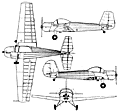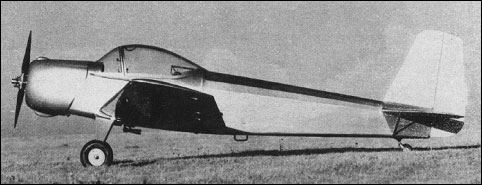|
| There is no text information for this aircraft at the moment.
| WEIGHTS |
| Take-off weight | 700 kg | 1543 lb |
| Empty weight | 470 kg | 1036 lb |
| DIMENSIONS |
| Wingspan | 9.56 m | 31 ft 4 in |
| Length | 7.06 m | 23 ft 2 in |
| Wing area | 15.0 m2 | 161.46 sq ft |
| PERFORMANCE |
| Max. speed | 160 km/h | 99 mph |
| Cruise speed | 142 km/h | 88 mph |
| Ceiling | 3000 m | 9850 ft |
| Range | 400 km | 249 miles |
 | A three-view drawing of Yak-20-I (800 x 745) |
| Eduardo Paiva, e-mail, 04.10.2021 14:27 The Yakovlev Yak-20 was an experimental piston-engined trainer developed in the Soviet Union in 1949. It did not go into production.
In 1949 the Yak-20 was designed by the Yakovlev OKB for use with aviation clubs as a trainer and sport aircraft. Intended to be the cheapest modern aircraft that could serve as a useful pilot trainer and aerobatic sport aircraft, the Yak-20 was intended to be considerably cheaper to build and operate than the contemporary Yak-18.
Though structurally similar to the Yak-18, the Yak-20 had a welded steel tube fuselage which was skinned with aluminium alloy sheet and fabric, with aluminium alloy wings, skinned in metal back to the single spar, and fabric aft of the spar. Accommodation was side by side under a large blown canopy, which slid open to the rear. The cockpit had dual stick controls, with the pilot sitting on the left. There was a central push-pull throttle, and simple gyro instruments. The engine was the newly developed Ivchenko AI-10 five-cylinder radial. This engine was small and extremely light. It was rated at 80 hp, driving a V-515 controllable-pitch counterweight propeller. Fuel was carried in two 35 liter (7.7 gallon) tanks in the wing roots, ahead of the single spar.
The Yak-20 was designed from the start to be fully aerobatic with very high spin resistance. The two prototypes were tested by pilots Anokhin and Georgii Shiyanov, and later by DOSAAF pilots, as well as a succession of leading aerobatic sport pilots who were invited to fly it. All were eager to see it put into production. State Acceptance trials followed, but the State evaluation team considered the Yak-20 too small and underpowered, recommending a redesign to match the performance of the Yak-18. Some of the criticisms of the State evaluation team were addressed in the second prototype, (Yak-20-2), which, as a result, became heavier and lost the performance edge of the first prototype. With Yak-18 production already in full swing, production of the Yak-20 was deemed superfluous. The final blow came when production of the small Ivchenko AI-10 engine was cancelled. reply | | Eduardo Paiva, e-mail, 04.10.2021 14:27 The Yakovlev Yak-20 was an experimental piston-engined trainer developed in the Soviet Union in 1949. It did not go into production.
In 1949 the Yak-20 was designed by the Yakovlev OKB for use with aviation clubs as a trainer and sport aircraft. Intended to be the cheapest modern aircraft that could serve as a useful pilot trainer and aerobatic sport aircraft, the Yak-20 was intended to be considerably cheaper to build and operate than the contemporary Yak-18.
Though structurally similar to the Yak-18, the Yak-20 had a welded steel tube fuselage which was skinned with aluminium alloy sheet and fabric, with aluminium alloy wings, skinned in metal back to the single spar, and fabric aft of the spar. Accommodation was side by side under a large blown canopy, which slid open to the rear. The cockpit had dual stick controls, with the pilot sitting on the left. There was a central push-pull throttle, and simple gyro instruments. The engine was the newly developed Ivchenko AI-10 five-cylinder radial. This engine was small and extremely light. It was rated at 80 hp, driving a V-515 controllable-pitch counterweight propeller. Fuel was carried in two 35 liter (7.7 gallon) tanks in the wing roots, ahead of the single spar.
The Yak-20 was designed from the start to be fully aerobatic with very high spin resistance. The two prototypes were tested by pilots Anokhin and Georgii Shiyanov, and later by DOSAAF pilots, as well as a succession of leading aerobatic sport pilots who were invited to fly it. All were eager to see it put into production. State Acceptance trials followed, but the State evaluation team considered the Yak-20 too small and underpowered, recommending a redesign to match the performance of the Yak-18. Some of the criticisms of the State evaluation team were addressed in the second prototype, (Yak-20-2), which, as a result, became heavier and lost the performance edge of the first prototype. With Yak-18 production already in full swing, production of the Yak-20 was deemed superfluous. The final blow came when production of the small Ivchenko AI-10 engine was cancelled. reply | | Eduardo Paiva, e-mail, 04.10.2021 14:27 The Yakovlev Yak-20 was an experimental piston-engined trainer developed in the Soviet Union in 1949. It did not go into production.
In 1949 the Yak-20 was designed by the Yakovlev OKB for use with aviation clubs as a trainer and sport aircraft. Intended to be the cheapest modern aircraft that could serve as a useful pilot trainer and aerobatic sport aircraft, the Yak-20 was intended to be considerably cheaper to build and operate than the contemporary Yak-18.
Though structurally similar to the Yak-18, the Yak-20 had a welded steel tube fuselage which was skinned with aluminium alloy sheet and fabric, with aluminium alloy wings, skinned in metal back to the single spar, and fabric aft of the spar. Accommodation was side by side under a large blown canopy, which slid open to the rear. The cockpit had dual stick controls, with the pilot sitting on the left. There was a central push-pull throttle, and simple gyro instruments. The engine was the newly developed Ivchenko AI-10 five-cylinder radial. This engine was small and extremely light. It was rated at 80 hp, driving a V-515 controllable-pitch counterweight propeller. Fuel was carried in two 35 liter (7.7 gallon) tanks in the wing roots, ahead of the single spar.
The Yak-20 was designed from the start to be fully aerobatic with very high spin resistance. The two prototypes were tested by pilots Anokhin and Georgii Shiyanov, and later by DOSAAF pilots, as well as a succession of leading aerobatic sport pilots who were invited to fly it. All were eager to see it put into production. State Acceptance trials followed, but the State evaluation team considered the Yak-20 too small and underpowered, recommending a redesign to match the performance of the Yak-18. Some of the criticisms of the State evaluation team were addressed in the second prototype, (Yak-20-2), which, as a result, became heavier and lost the performance edge of the first prototype. With Yak-18 production already in full swing, production of the Yak-20 was deemed superfluous. The final blow came when production of the small Ivchenko AI-10 engine was cancelled. reply | | Barry, 08.12.2016 12:12 Only two of this small robust aerobatic trainer were built. Powered by an 80 h.p. Ivchenko Al-10 5 cylinder radial, it was well received by all who flew it but the authorities deemed it to small and so no production was forthcoming. reply |
|
Do you have any comments?
|
| 
COMPANY
PROFILE
All the World's Rotorcraft
|











